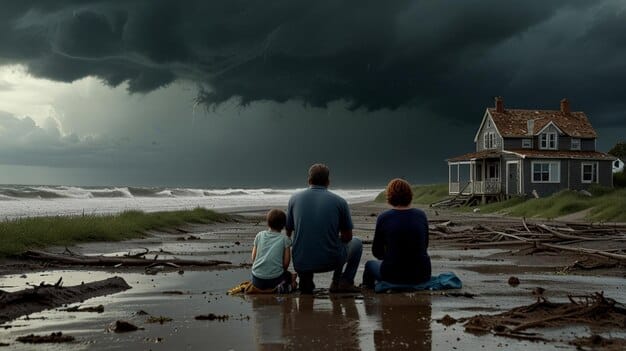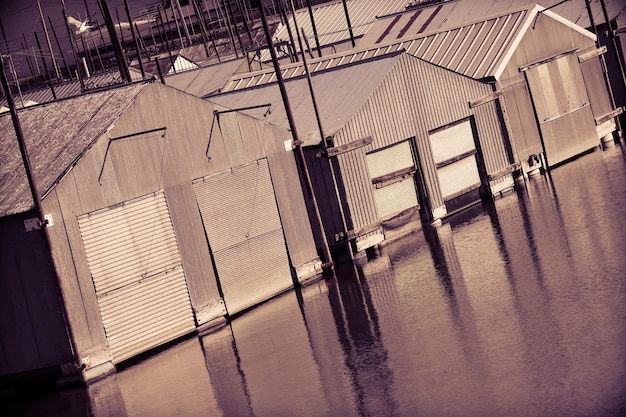The Economic Impact of Extreme Weather: Preparing Your Finances

The Economic Impact of Extreme Weather: How to Prepare Your Finances explores the significant financial consequences of events such as heat waves, hurricanes, and floods, offering strategies to mitigate risks through insurance, emergency funds, and resilient investments.
The increasing frequency and intensity of extreme weather events are no longer just environmental concerns; they are significant economic threats. Understanding the economic impact of extreme weather: how to prepare your finances is crucial for every household and business in the face of these growing challenges.
Understanding the Financial Risks of Extreme Weather
Extreme weather events can trigger a cascade of financial hardships. From immediate property damage to long-term economic instability, the risks are multifaceted and far-reaching.
Direct Costs of Damage and Disruption
The most immediate financial impact comes from the direct costs of damage to homes, businesses, and infrastructure. Hurricanes, floods, and wildfires can cause widespread destruction, leading to significant repair or replacement expenses.
Indirect Economic Consequences
Beyond direct damage, extreme weather can disrupt supply chains, impact agricultural yields, and lead to business closures, resulting in job losses and reduced economic activity. These indirect consequences can ripple through communities for months or even years.

- Increased Insurance Premiums: Insurers often raise premiums in areas prone to extreme weather, adding to the financial burden.
- Loss of Property Value: Homes in high-risk areas may experience a decline in property value, affecting long-term wealth.
- Healthcare Costs: Extreme weather events can lead to increased healthcare costs due to injuries, stress-related illnesses, and the spread of diseases.
In conclusion, understanding both the direct and indirect financial risks associated with extreme weather is the first step in preparing your finances effectively.
Assessing Your Personal Financial Vulnerability
Before taking steps to protect your finances, it’s essential to assess your personal vulnerability to extreme weather events. This involves evaluating your location, insurance coverage, and financial resources.
Evaluate Your Location’s Risk Profile
Different regions face different types of extreme weather threats. Research the historical weather patterns in your area and identify the most likely risks, such as hurricanes, floods, wildfires, or heatwaves.
Review Your Insurance Coverage
Ensure that your homeowners, renters, or business insurance policies adequately cover the types of damage most likely to occur in your region. Pay close attention to exclusions and limitations.

Calculate Your Financial Resilience
Determine how easily you could recover financially from a major weather event. Consider your savings, access to credit, and ability to generate income in the aftermath of a disaster.
- Emergency Fund Adequacy: Aim to have at least three to six months’ worth of living expenses in an easily accessible emergency fund.
- Debt Levels: High debt levels can make it harder to recover financially from a weather-related setback.
- Income Stability: Assess the stability of your income and consider diversifying your income streams if possible.
In summary, accurately assessing your personal financial vulnerability is crucial for identifying the specific steps you need to take to protect yourself and your family.
Building an Emergency Fund for Weather-Related Crises
An emergency fund is a critical component of financial preparedness for extreme weather. It provides a cushion to cover unexpected expenses and lost income in the aftermath of a disaster.
Determining the Right Size for Your Fund
The ideal size of your emergency fund depends on your individual circumstances, including your monthly expenses, income stability, and risk tolerance. A general guideline is to save three to six months’ worth of living expenses.
Strategies for Building Your Fund Quickly
If you don’t already have an emergency fund, start building one as soon as possible. Even small contributions can add up over time. Consider setting up automatic transfers from your checking account to a savings account.
Accessibility and Liquidity
Ensure that your emergency fund is easily accessible and liquid. High-yield savings accounts or money market accounts are good options. Avoid investing your emergency fund in stocks or other volatile assets.
- Cut Unnecessary Expenses: Identify areas where you can reduce spending and redirect those funds to your emergency savings.
- Automate Savings: Set up automatic transfers from your checking account to your emergency fund each month.
- Treat it Like a Bill: Prioritize saving for your emergency fund as if it were a non-negotiable monthly expense.
In conclusion, building a robust emergency fund is an essential step in preparing your finances for the unexpected costs associated with extreme weather events.
Reviewing and Updating Insurance Policies
Insurance is a crucial tool for mitigating the financial impact of extreme weather. However, it’s important to review and update your policies regularly to ensure they provide adequate coverage.
Homeowners Insurance: Key Coverage Areas
Homeowners insurance typically covers damage to your home and personal property from covered perils, such as fire, wind, and hail. However, it may not cover flood damage, which requires a separate flood insurance policy.
Flood Insurance: Understanding Your Options
If you live in a flood-prone area, flood insurance is essential. The National Flood Insurance Program (NFIP) offers coverage to homeowners, renters, and business owners in participating communities.
Business Insurance: Protecting Your Livelihood
Business owners should review their insurance policies to ensure they cover property damage, business interruption, and liability claims related to extreme weather events.
- Review Coverage Limits: Make sure your coverage limits are high enough to cover the full cost of rebuilding or repairing your property.
- Understand Exclusions: Be aware of any exclusions in your policies, such as damage from earthquakes or landslides.
- Update Your Inventory: Keep a detailed inventory of your personal property or business assets to facilitate the claims process.
In summary, regularly reviewing and updating your insurance policies is a critical step in ensuring you have adequate financial protection in the event of extreme weather.
Diversifying Investments for Long-Term Financial Security
While an emergency fund and adequate insurance can help you weather short-term financial shocks, diversifying your investments is essential for long-term financial security in the face of climate change.
Resilient Investment Strategies
Consider investing in companies and industries that are well-positioned to adapt to climate change, such as renewable energy, water management, and sustainable agriculture.
Geographic Diversification
Avoid concentrating your investments in regions that are particularly vulnerable to extreme weather events. Geographic diversification can help protect your portfolio from localized economic shocks.
ESG Investing
Environmental, social, and governance (ESG) investing focuses on companies that are committed to sustainability and responsible business practices. ESG funds may be more resilient in the face of climate-related risks.
- Reduce Exposure to High-Risk Sectors: Consider reducing your exposure to industries that are heavily reliant on fossil fuels or that contribute to deforestation.
- Invest in Green Bonds: Green bonds are debt instruments used to finance environmentally friendly projects.
- Seek Professional Advice: Consult with a financial advisor to develop an investment strategy that aligns with your risk tolerance and financial goals.
In conclusion, diversifying your investments is crucial for building long-term financial security in a world increasingly affected by extreme weather.
Community Resilience and Government Programs
Individual financial preparedness is important, but community resilience and government programs also play a vital role in mitigating the economic impact of extreme weather.
Community-Based Initiatives
Participate in community-based initiatives that promote disaster preparedness and resilience. These may include neighborhood watch programs, volunteer organizations, and local government initiatives.
Government Assistance Programs
Familiarize yourself with government assistance programs that are available to individuals and businesses affected by extreme weather events. These may include FEMA disaster assistance, SBA loans, and state-level programs.
Advocacy for Climate Action
Support policies and initiatives that address climate change and promote resilience to extreme weather. This may involve contacting your elected officials, supporting environmental organizations, or participating in climate advocacy campaigns.
- Stay Informed: Stay informed about local weather alerts and emergency preparedness plans.
- Participate in Drills: Participate in community-wide disaster drills to practice your response plans.
- Support Local Businesses: Support local businesses that are committed to sustainability and resilience.
In summary, community resilience and government programs are essential for creating a more equitable and sustainable response to the economic challenges posed by extreme weather.
| Key Point | Brief Description |
|---|---|
| ⚠️ Emergency Fund | Essential for covering unexpected weather-related expenses. |
| 🛡️ Insurance Review | Regularly check and update policies for adequate coverage. |
| 🌱 Diversify Investments | Invest in resilient, sustainable sectors for long-term security. |
| 🤝 Community Support | Engage in local preparedness and climate action initiatives. |
Frequently Asked Questions (FAQ)
▼
Check local government websites, NOAA, and FEMA for historical weather data and risk maps specific to your location.
▼
Homeowners insurance typically covers wind damage. Flood damage requires a separate flood insurance policy.
▼
Aim for three to six months’ worth of living expenses in an easily accessible savings account.
▼
Consider investing in renewable energy, water management, and sustainable agriculture companies that are adapting to climate change.
▼
Visit FEMA’s website for information on disaster assistance programs and application procedures. Also, check local and state government resources.
Conclusion
Preparing your finances for the economic impact of extreme weather is an ongoing process that requires careful planning, regular review, and a commitment to building both individual and community resilience. By taking proactive steps to assess your vulnerability, build an emergency fund, update your insurance policies, and diversify your investments, you can protect your financial well-being in the face of increasingly frequent and intense weather events.





